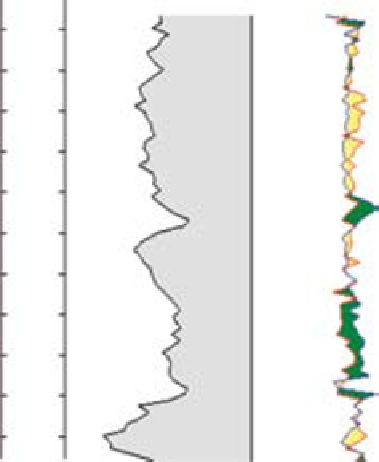Geoscience Reference
In-Depth Information
(B)
GRAIN SIZE AND SEDIMENTA RY
STRUCTURES
SAND
NPHI
Depth
(m)
FACIES
ASS.
0.75
%
-0.15
Zone
LITHOLOGY
GR
RHOB
g/cc
CLAY
VF
F
MC C
0
API
250
1.45
2.95
FA 1
2771
2772
FA 6
2773
2774
FA 8
2775
FA 9
2776
2777
FA 8
2778
2779
FA 7
2780
FA 6
2781
Fig. 16.
(
Continued
) (B) Typical log signatures of brackish-water interdistributary bay facies (from well 6507/7-A-46). The
dashed blue box corresponds to the cored interval in Fig. 16A. Note the upward-coarsening/cleaning trend of FA 8, reflect-
ing a bay-fill unit (top and base are indicated on the core photo). The base is characterised by carbonaceous bay-floor muds
(FA 7) which grade upwards into a heterolithic 'transition zone' and, finally, a sand-dominated wave-reworked upper part
(FA 8). The top boundary of this bay-fill unit shows rooting and carbonaceous siltstones corresponding to bay margin muds
(FA 9). See Fig. 14 and text for further descriptions of the different facies associations (see Fig. 6A for core description
legend and Fig. 4 for abbreviations).
Upward coarsening/cleaning bay-fills thus reflect
progradation of sandy delta lobes across the
muddy bay floor following autocyclic abandon-
ment and subsidence of adjacent delta lobes
along the coast (Fig. 17). Sedimentation in a sys-
tem of this kind is mainly due to crevasse splay
processes, represented either by crevasse chan-
nels cutting the levee of distributary channels
and forming sheet floods into the adjoining bays
(e.g. Mississippi delta; cf. Roberts, 1997; Roberts
& Coleman, 1996), or by avulsion of the distribu-
tary channel itself into the adjacent bay (Elliot,
1974). A dominance of distributary channel
facies relative to crevasse facies may indicate
that the latter process have been the most impor-
tant one during deposition of the Åre reservoir
zones 3 and 4. Depending upon location with
respect to sediment input points and incident
wave activity, the margins of the embayments
might comprise clean, wave-dominated sands of
shoreface origin in one location and low-energy
heteroliths and muddy deposits in another.
Despite this complex facies distribution, well-
to-well correlations of individual bay-fill cycles
can be made laterally in areas with closely
spaced wells.
Repeated marine incursions onto the low-relief
coastal plain during deposition of Åre 3 and 4
Zones resulted in characteristic brackish water
bay-floor mud deposits, typically seen as 0.5 m to
1 m thick beds in the stratigraphy. These mud-
stones serve to define candidate flooding surfaces
bounding reservoir sub-zones. The Åre 3 and 4
Zones are separated by a field-wide flooding sur-
face associated with a singificant shift in the
depostional style (MFS2; Fig. 18).
Åre 3 Zone
This reservoir zone (60 m to 70 m thick) marks a
transition from a fluvial-dominated setting in the
underlying Åre 2 Zone to a system displaying sig-
nificant brackish-water influence and the first
development of shallow-water bays (Fig. 7B).
























































































































Search WWH ::

Custom Search